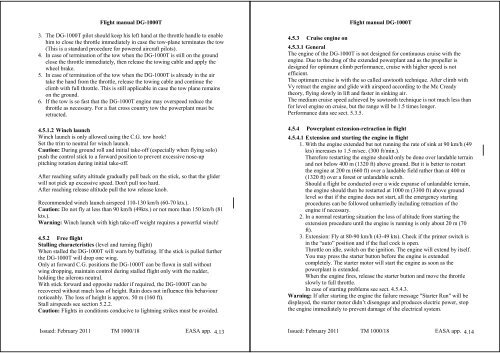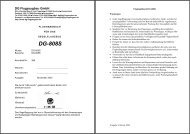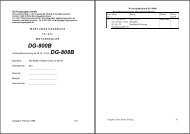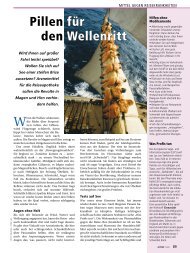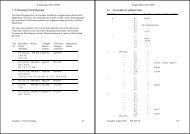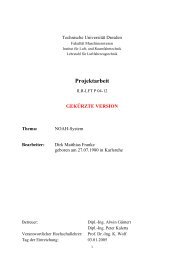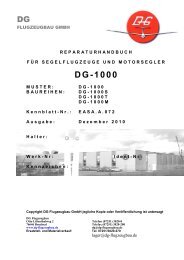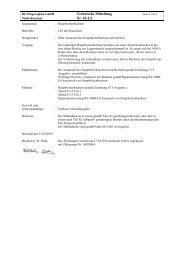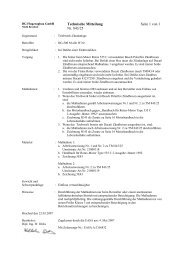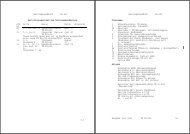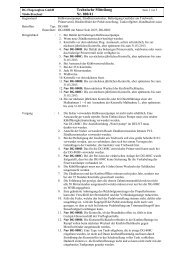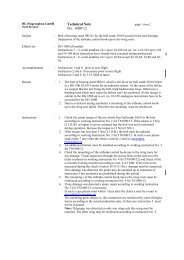DG-1000T - DG Flugzeugbau
DG-1000T - DG Flugzeugbau
DG-1000T - DG Flugzeugbau
You also want an ePaper? Increase the reach of your titles
YUMPU automatically turns print PDFs into web optimized ePapers that Google loves.
Flight manual <strong>DG</strong>-<strong>1000T</strong><br />
3. The <strong>DG</strong>-<strong>1000T</strong> pilot should keep his left hand at the throttle handle to enable<br />
him to close the throttle immediately in case the tow-plane terminates the tow<br />
(This is a standard procedure for powered aircraft pilots).<br />
4. In case of termination of the tow when the <strong>DG</strong>-<strong>1000T</strong> is still on the ground<br />
close the throttle immediately, then release the towing cable and apply the<br />
wheel brake.<br />
5. In case of termination of the tow when the <strong>DG</strong>-<strong>1000T</strong> is already in the air<br />
take the hand from the throttle, release the towing cable and continue the<br />
climb with full throttle. This is still applicable in case the tow plane remains<br />
on the ground.<br />
6. If the tow is so fast that the <strong>DG</strong>-<strong>1000T</strong> engine may overspeed reduce the<br />
throttle as necessary. For a fast cross country tow the powerplant must be<br />
retracted.<br />
4.5.1.2 Winch launch<br />
Winch launch is only allowed using the C.G. tow hook!<br />
Set the trim to neutral for winch launch.<br />
Caution: During ground roll and initial take-off (especially when flying solo)<br />
push the control stick to a forward position to prevent excessive nose-up<br />
pitching rotation during initial take-off.<br />
After reaching safety altitude gradually pull back on the stick, so that the glider<br />
will not pick up excessive speed. Don't pull too hard.<br />
After reaching release altitude pull the tow release knob.<br />
Recommended winch launch airspeed 110-130 km/h (60-70 kts.).<br />
Caution: Do not fly at less than 90 km/h (49kts.) or not more than 150 km/h (81<br />
kts.).<br />
Warning: Winch launch with high take-off weight requires a powerful winch!<br />
4.5.2 Free flight<br />
Stalling characteristics (level and turning flight)<br />
When stalled the <strong>DG</strong>-<strong>1000T</strong> will warn by buffeting. If the stick is pulled further<br />
the <strong>DG</strong>-<strong>1000T</strong> will drop one wing.<br />
Only at forward C.G. positions the <strong>DG</strong>-<strong>1000T</strong> can be flown in stall without<br />
wing dropping, maintain control during stalled flight only with the rudder,<br />
holding the ailerons neutral.<br />
With stick forward and opposite rudder if required, the <strong>DG</strong>-<strong>1000T</strong> can be<br />
recovered without much loss of height. Rain does not influence this behaviour<br />
noticeably. The loss of height is approx. 50 m (160 ft).<br />
Stall airspeeds see section 5.2.2.<br />
Caution: Flights in conditions conducive to lightning strikes must be avoided.<br />
Issued: February 2011 TM 1000/18 EASA app. 4.13<br />
Flight manual <strong>DG</strong>-<strong>1000T</strong><br />
4.5.3 Cruise engine on<br />
4.5.3.1 General<br />
The engine of the <strong>DG</strong>-<strong>1000T</strong> is not designed for continuous cruise with the<br />
engine. Due to the drag of the extended powerplant and as the propeller is<br />
designed for optimum climb performance, cruise with higher speed is not<br />
efficient.<br />
The optimum cruise is with the so called sawtooth technique. After climb with<br />
Vy retract the engine and glide with airspeed according to the Mc Cready<br />
theory, flying slowly in lift and faster in sinking air.<br />
The medium cruise speed achieved by sawtooth technique is not much less than<br />
for level engine on cruise, but the range will be 1.5 times longer.<br />
Performance data see sect. 5.3.5.<br />
4.5.4 Powerplant extension-retraction in flight<br />
4.5.4.1 Extension and starting the engine in flight<br />
1. With the engine extended but not running the rate of sink at 90 km/h (49<br />
kts) increases to 1.5 m/sec. (300 ft/min.).<br />
Therefore restarting the engine should only be done over landable terrain<br />
and not below 400 m (1320 ft) above ground. But it is better to restart<br />
the engine at 200 m (660 ft) over a landable field rather than at 400 m<br />
(1320 ft) over a forest or unlandable scrub.<br />
Should a flight be conducted over a wide expanse of unlandable terrain,<br />
the engine should then be restarted at 1000 m (3300 ft) above ground<br />
level so that if the engine does not start, all the emergency starting<br />
procedures can be followed unhurriedly including retraction of the<br />
engine if necessary.<br />
2. In a normal restarting situation the loss of altitude from starting the<br />
extension procedure until the engine is running is only about 20 m (70<br />
ft).<br />
3. Extension: Fly at 80-90 km/h (43-49 kts). Check if the primer switch is<br />
in the “auto” position and if the fuel cock is open.<br />
Throttle on idle, switch on the ignition. The engine will extend by itself.<br />
You may press the starter button before the engine is extended<br />
completely. The starter motor will start the engine as soon as the<br />
powerplant is extended.<br />
When the engine fires, release the starter button and move the throttle<br />
slowly to full throttle.<br />
In case of starting problems see sect. 4.5.4.3.<br />
Warning: If after starting the engine the failure message "Starter Run" will be<br />
displayed, the starter motor didn’t disengage and produces electric power, stop<br />
the engine immediately to prevent damage of the electrical system.<br />
Issued: February 2011 TM 1000/18 EASA app. 4.14


